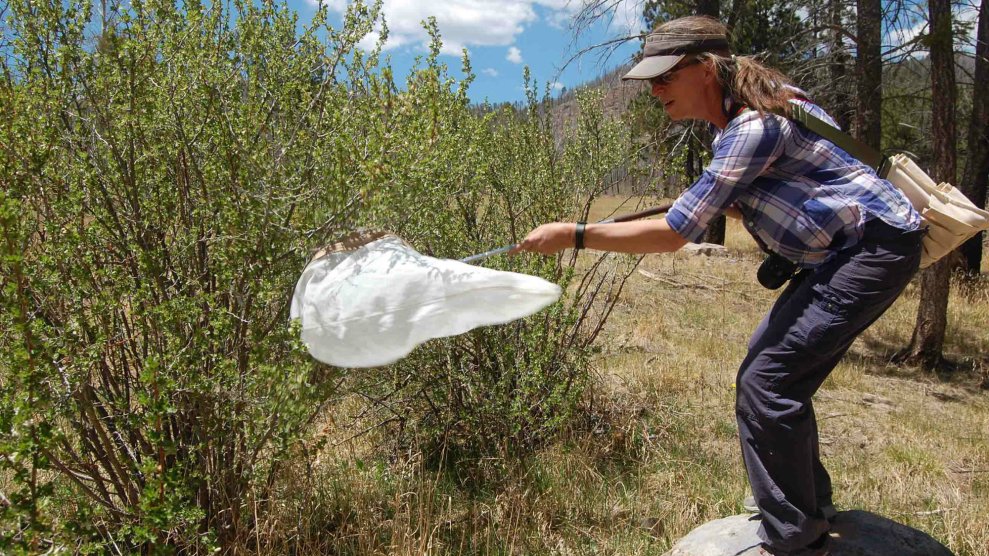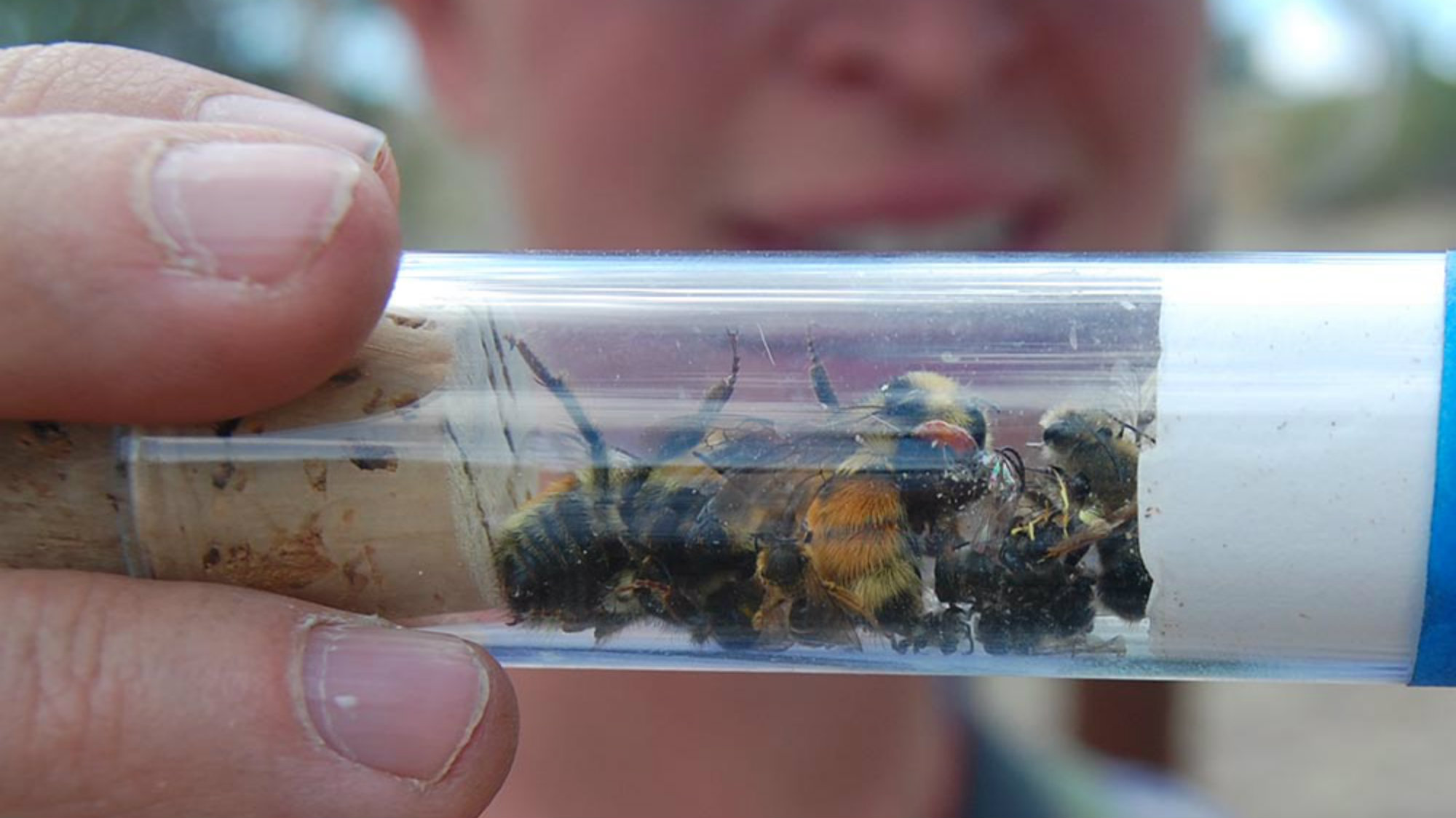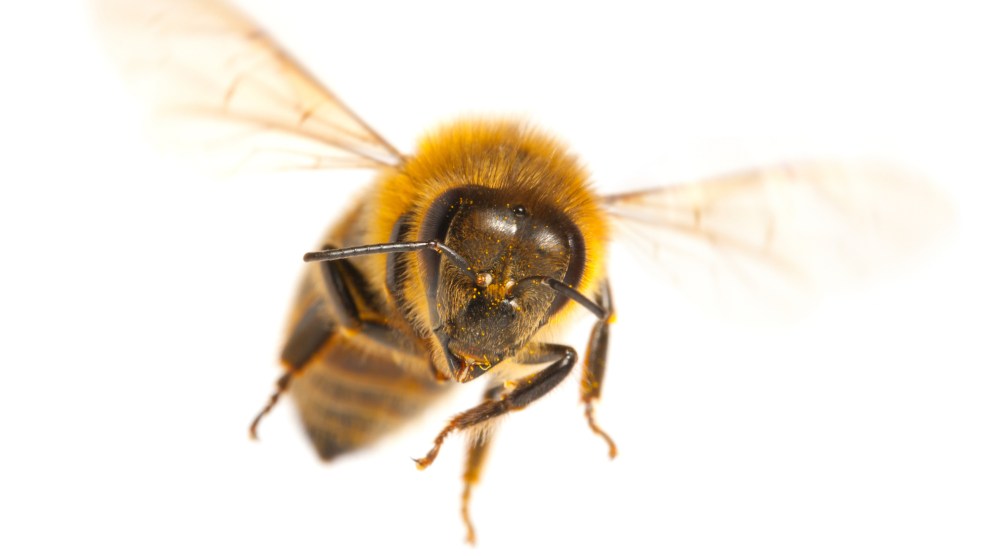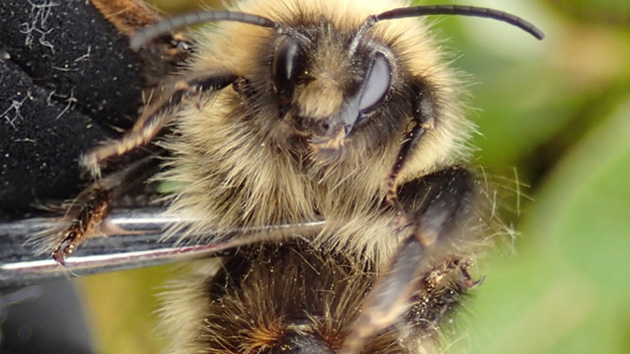
Olivia Carril (above) has added dozens of species to the list of bees documented in Bandelier National Monument.Sara Van Note
This story was originally published by Undark and appears here as part of the Climate Desk collaboration.
A cluster of leafcutter bees are foraging for nectar and pollen on an unseasonably hot May morning in Bandelier National Monument, in northern New Mexico. Tiny, with few bright markings, they don’t look like bees at first—more like dark-colored buzzy insects.
But Olivia Carril is excited to spot them on penstemon plants, whose pale purple flowers have bright magenta stripes that guide the leafcutters down their long tubes to the nectar, past the anthers for a dusting of pollen. She scoops a handful of bees into her net, then quickly transfers them to glass vials.
Until Carril, an independent scientist and co-author of a field guide to North American bees, began her survey a year ago, it was unknown how many bees were in Bandelier: Just two species had been documented in one part of the monument, which climbs from lush riparian zones to piñon-juniper foothills to alpine forests. But in just a year, she has added at least 46 species to the list.
The public often hears stories of bees at risk, with honeybees threatened by colony collapse disorder and the first U.S. mainland bee, the rusty patched bumblebee, listed as endangered in 2017. But scientists like Carril are showing that the picture is more complicated for native bees, raising a host of questions about widespread pesticide use, habitat loss, and climate change.
Desert bees have a unique set of strategies to survive harsh conditions. And bees are most diverse in arid environments the world over, suggesting their persistence during past eras of drought. Will their strategies prove sufficient in an era of anthropogenic climate change? Is there time to learn more about native bees before it’s too late?
Karen Wright documents New Mexico’s bees from the edge of the Chihuahuan Desert at the Sevilleta National Wildlife Refuge. Her study is one of the longest-running bee surveys in the world: It began in 2002 and is entering its 17th year.
Despite the critical role bees play in diverse ecosystems, huge swaths of the U.S. remain unsurveyed. Out of some 4,330 North American and Hawaiian native bee species (a quarter of them found in New Mexico), there’s sufficient data to assess only 1,437, according to the Center for Biological Diversity.
When Wright started working at the Sevilleta in 2000, she was fascinated by the dramatic changes in the plant community in response to rain and other factors. And she was curious about the many species of bees that depended on them. How were they managing to survive when the desert landscape changed so drastically from year to year?
Now the assistant curator for the Texas A&M insect collection, she has identified nearly 300 species at the Sevilleta, and she says each is unique, with different tolerances to changing conditions—“so some of the bees are more resilient than others to drought.”
She also made promising discoveries, like a mason bee endemic to the Rio Grande Valley that hadn’t been collected in nearly 100 years—she describes it as “gorgeous bright blue,” with red hair. And she has identified 11 new species in the 360-square-mile wildlife refuge, with a dozen more undescribed. As she says, “You don’t have to go to the Amazon to find new species.”
But the Sevilleta has endured a decade of drought, and Wright has also documented the disappearance of some species of bees, which she says may mean local extinction. To know for sure, she’s waiting for this drought cycle to end. And no one knows when that will be.
Most bee studies last just three years, she says—too short to show long-term trends. “These continuous long-term studies are so important for really understanding how the landscape changes, how the bees and the flowers recover after drought,” Wright says.
But by the time the long-term data is available, Wright says, climate change may be “so bad that those effects are already permanent.”
Still, she hopes her study will outlast the “the tragedy of the drought,” “so I can really tell a whole story.” With more time, “maybe I can show the beauty of the recovery and the resilience of the desert.”
Bee scientists have lots of questions about biology, diet, nesting, survival strategies…and few answers. In her survey of bees at Bandelier National Monument, Olivia Carril hopes to reveal a more complete picture by documenting the plants they visit. At a bright yellow aster, she nets a species even though she’s already collected it, because it’s visiting a different plant. “If you want to talk about the plant pollinator network,” she says, “the plant part is as important as the bee part.”
Despite two extreme wildfires in the past two decades, Carril’s data for 2017 showed bees were both abundant and diverse in burn scars. Once the tree canopy is denuded by fire, understory plants are able to take advantage of sunlight and space, and plant diversity may increase, she says. Carril says bees are opportunistic, and “flowers and bees go together.”
This year will be a test for the resilience of New Mexico’s diverse environments. Eighty percent of the state is in severe to exceptional drought, and models of climate change suggest drought intensity will increase across the state.
At Carril’s high-elevation survey site in Bandelier, the landscape changes to hummocks of grass and scattered ponderosa pines, many with bark singed black. She surveys the abundant dandelions and quickly locks on a gooseberry bush buzzing with activity. “I am about to go collect a whole bunch of bees,” she says with a laugh, and pauses a beat before swooping in with her net.
The gooseberry, dense with tiny white flowers loaded with nectar, is full of bumblebees, quick gray digger bees, mining bees, and other “generalist” bees that aren’t picky about their food. Since it’s so dry this spring, there are fewer plants in bloom, and not as many bees to catch. Still, Carril counts more than 30 in her vials at the end of the day. “If this were peak bee season and this were how many bees I got, I think I’d be pretty disappointed,” she says, “but for not seeing many flowers in bloom today, I think we’ve done remarkably well.”
The arid Southwest is one of the hotspots of bee diversity in the world, with an abundance of “specialist” species, bees that rely on just one group of plants—generally a common, widespread group like prickly pear or sunflower. Around the world, there’s a higher proportion of specialist bees in arid environments than in humid ones. But scientists don’t know why.
“One interpretation is that to survive in really hot, unpredictable parts of the desert you need to be able to be synchronized with that plant very well,” says Bob Minckley, a professor of biology at the University of Rochester. He has led long-term studies of bees in the Southwest, including those that specialize on mesquite trees, which tap into groundwater and don’t require rain to bloom.
Since their adult stage is so short, often just six weeks, specialist bees must time their emergence to coincide with the bloom of their host plants. Those flowers can be short-lived too; “plants up here seem to flash,” Carril says. In northern New Mexico, evening primrose blooms briefly in May, and cholla cactus in June and July.
One theory to explain this synchronization is that specialist bees respond to the same cues their host plants do, like moisture. Then the bee larvae or pupae, usually in ground nests, emerge in time to feed on their preferred plant. Seventy percent of native bees are ground-nesters, and the vast majority are solitary, with each female building her own nest.

Native bees from one day’s haul at Bandelier National Monument.
Sara Van Note
Bryan Danforth, an entomologist at Cornell University, travels from his lab in upstate New York to the Southwestern desert each summer. It’s “like paradise for a bee biologist,” he says. “There’s incredible things out there that are poorly studied.”
One of his studies of desert bees aimed to replicate exposure to rainfall in a lab setting. He found that larvae of a tiny ground-nesting desert bee did emerge in response to moisture. “It’s almost like bang, you get the high humidity, you get this pattern of emergence,” he says. His study also found evidence of bet-hedging: Some larvae became adults in one year and others in following years. This may be another critical strategy for desert bees, spreading the risk of emergence to minimize loss in drought years.
Another strategy may be spending the winter underground, as thick-skinned larvae or pupae. The bee larvae are like the seeds of annual plants that remain dormant until the right time to burst forth, Danforth says, a mirror of the very plants many bees depend on.
In an era of climate change and increasing drought, specialization may provide an advantage. While generalist bees that forage on a wide range of plants seem to emerge every year, specialists may wait out the years with poor conditions and low precipitation. Since droughts are unpredictable, the specialists might be the winners, Minckley says, “because they’ll come out or not come out in the right years.”
Still, it’s extremely difficult to know how bees are doing now, much less predict how they might respond to climate change in the future. The Southwest’s last extended drought occurred in the 1950s, but there’s very little information about bee communities before then. “That’s a big problem,” Minckley says. There’s very little baseline data, he says, and bee populations naturally fluctuate from year to year. “To see a downward trend would take a lot of sampling” and a lot of effort.
That’s one reason studies like Carril’s and Wright’s are important. Carril says she’s optimistic about bees’ responses to climate change. “It makes me really curious,” she says. “One thing I know about bees is they like dry and hot.”
Bryan Danforth acknowledges the remarkable adaptations of desert bees to unpredictability in their environment. But with climate change, “these bees are going to be pushed to their limits in terms of their ability to survive.”
At Carril’s high-elevation site, another gooseberry bush attracts a varied collection of bees nosing in its flowers. Carril wonders whether the charred stump next to it could be a home for a cavity-nesting bee. “If it’s too burned,” she says, “it’s probably disintegrating inside, probably not the best bee habitat.”
Suddenly a little black bee zooms down to the hole and disappears inside, then zips back out. Carril gasps in surprise, “Did you see that?”
A resourceful bee is making her nest in the blackened stump after all. Carril sits nearby, patiently waiting for the bee to return. “I’m gonna get comfortable,” she says. “This is worth it.”
Disclosure: Van Note is a part-time employee at the University of New Mexico School of Law; an unrelated department at the university supports Karen Wright’s bee survey in the Sevilleta National Wildlife Refuge.












